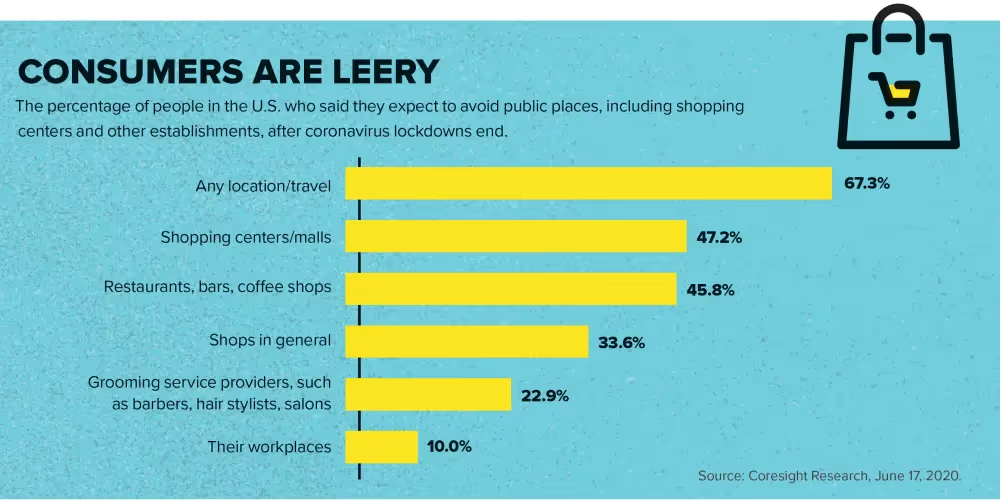Two years ago, if you has asked an HR professional about the top HR challenges in the retail sector, they likely would have listed employee turnover and the brutal war for talent. But, all those concerns took a back seat when Covid-19 emerged, bringing with it a set of new and unprecedented challenges.
The loss of key staff being lured away by the promise of more pay from the competition was overshadowed by an even greater crisis by the likes of the Great Resignation and rapid digital transformation.
The e-commerce shift was well underway before the pandemic appeared. Their growth significantly accelerated due to the the shuttering of nonessential physical stores. And even after the reopening of various establishments, the aftermath of the pandemic and lack of Covid-19 vaccines led to many customers fearing for their health and wary about venturing out of there homes. The retail sector was in a state of turmoil.
Despite the challenges set by the pandemic, some constants remain. In the face of an uncertain revenue flow, companies must still decide which employees to bring back and when. Culture and engagement remain critical components of a happy and productive workforce. Training is still important, but it now includes instructions for staff working remotely as well as front-line workers who are concerned about infection.
As retailers adapt to new ways of working and shopping, HR will need to demonstrate empathy and flexibility. Let’s explore some of the key challenges of HR in the retail sector and how to solve them.

Top HR challenges in retail - And how to solve them
1. Addressing staffing shortages through recruitment and retention
Recruiting and retaining employees has been one of the most key challenges of HR in the retail sector in recent years. According to the U.S. Bureau of Labor Statistics, the retail industry has the second-highest number of vacant positions of any sector, with over 10 million openings.
According to a Zipline survey, 42 percent of retail associates are considering or planning to leave the industry. This is largely the result of a communication breakdown between corporate headquarters and shop floor staff, which makes employees feel ignored, disengaged, and cut off from the business.
HR is tasked with the difficult task of addressing these challenges. They must devise novel approaches to attracting and retaining employees in a volatile industry. This includes the following:
- Increasing employee engagement
- Rewarding good performance
- Raising wages and benefits
- Providing regular schedules and a set number of hours
- Conducting more in-depth exit interviews to better understand issues and what employees are actively looking for in a company.
Salary and benefit increases are always appreciated. However, this is no longer sufficient to distinguish an organisation from its competitors. Employees are increasingly expecting more from their workplace.
Furthermore, the pandemic has focused attention on employees' mental health. According to the American Psychological Association, 78 percent of workers are under significant stress. The psychological effects of the pandemic are manifesting themselves in an increase in substance abuse, domestic violence, and suicides.
Businesses that are paying attention to the HR challenges in the retail sector are beginning to prioritise their employees' mental health by appointing a Director of Wellbeing and providing health-related benefits to provide relief during difficult times.
2. Employee safety
According to the American Bureau of Labor Statistics, the retail industry added 135,000 jobs in December 2020 but lost 38,000 jobs in January 2021. In addition to job losses, COVID-19 has raised concerns about employee safety, with front-line retail staff constantly exposed to the virus.
Employee safety will continue to be a top retail concern in the coming years. To safeguard the health and wellbeing of both employees and customers, HR is tasked with conducting routine research and implementing new and updated safety measures as necessary. This includes basic measures such as cleaning all workspaces on a regular basis, ensuring employees have all the cleaning supplies they need during their shift, and running the business in a way that eliminates or reduces contact.
3. Redefining HR's function within the company
HR departments are becoming an essential part of all organisations and a strategic partner to businesses. However, one of the HR challenges in the retail industry is that HR business partners (HRBPs) frequently take a very reactive approach, waiting for orders from management. Instead, we must strive to be more proactive by developing data-driven solutions.
To accomplish this, HR professionals should concentrate on becoming T-shaped. This indicates that they are proficient in at least one functional HR competency, such as talent acquisition or L&D, as well as the four core HR competencies of data literacy, business acumen, people advocacy, and digital proficiency.
Combining these abilities will enable HR professionals to communicate in business terms. As a result, they will remain relevant in an ever-changing business landscape and assist their organisation in meeting business objectives by continuously driving value that improves the bottom line.
4. Providing a digital employee experience
76% of retail workers think that adopting digital processes would boost their output. In order to provide the positive digital employee experience that employees now demand, HR professionals must be savvy with technology themselves. Although providing this experience is one of the crucial HR challenges in the retails sectors, HR specialists must actively listen to their workforce and pose this question in order to comprehend what needs of employees are best. This makes employees feel heard, valued, and connected to the organisation.
Due to technological advancements and with the available retail data analytics we see the retail industry is rapidly changing.. The pandemic has accelerated this change faster than many expected. Employers must carefully consider what new skills workers will need to perform various duties and tasks. For instance, using platforms for scheduling and time management, mobile messaging services, pay-per-view platforms, and learning and development platforms.
Furthermore, providing extensive training and development reassures concerned employees that their future with the company is secure. Workers can access training throughout their shift that is tailored to their individual needs through a user-friendly and entertaining app.

5. Making the workplace more diverse and inclusive
The impact of unconscious bias on hiring decisions has been well evidenced. Despite being one of the most diverse industries, retail, the workplace has had difficulty reflecting this, especially at the highest executive levels.
According to the Equal Employment Opportunity Commission, only 14% of top executive employees in retail come from underrepresented groups. According to a McKinsey survey, 39% of respondents declined an offer of employment because they believed the company lacked an inclusive culture. And according to a startling 75% of participants in a Harvard Business Review survey, diversity policies have no impact on their organisations unless the top executives are committed to enacting change.
Beyond racial differences, these HR challenges in the retail sector also have an impact on other demographics, such as age, ability, and gender. Retailers must provide equal opportunity training to prevent these claims of discrimination.
The transition from promising to delivering a diverse and inclusive workplace is a huge HR challenge in the retail sector. Pre-employment testing and behavioural assessments are two examples of tech-driven HR tools that can be used to assess talent and promote inclusivity. Making such tests anonymous can also assist HR professionals in making objective hiring decisions.
The talent pipeline that fills these roles is equally non-diverse, which is the obvious cause of the lack of diversity among executive teams. Therefore, HR must concentrate on developing diverse, experienced candidates within the company.
Wider groups of people will be able to continue competing for positions in higher positions as a result. Building a more diverse and inclusive workplace where no one feels excluded and everyone feels like they belong can be aided by initiatives like mentoring, coaching, and sponsorship programmes.
6. Career advancement
People frequently consider retail jobs to be temporary positions for young adults who will eventually move on to pursue another career. Employees are less likely to be engaged when they do not see opportunities for advancement, and businesses suffer as a result.
Retail businesses must show that career advancement is possible and design lateral and leadership career paths in order to reduce attrition and enhance the employee experience.
The qualifications needed to move from a sales associate to a manager or a corporate title should be made clear to employees who want to move into management. Build career paths within a role or allow staff to specialise in a particular area of the store to discourage lateral moves.
Career paths in retail can also be developed in response to emerging needs. For instance, as more retailers use software, they might train staff members who are interested in working in IT.
7. Sexual harassment
Sexual harassment is a common issue for retail employees, whether the inappropriate behaviour is perpetrated by customers, managers, or coworkers. This is a critical HR challenge in the retail industry and is not surprising given that retailers frequently employ young people or those in economically precarious situations. Because the employees are frequently younger or more financially dependent on their jobs, harassment is more likely to occur in the retail industry. As a result, victims are often reluctant to speak up or report the harassment.
Employers are required by law to maintain safe working environments, and if they permit inappropriate behaviour to persist, they risk employment claims. Employers must have a sexual harassment policy in place and adhere to it in order to address any issues that may arise and prevent them altogether.
Managers ought to receive regular training and be made aware of the need to report any sexual harassment. When problems arise, the company must commit to taking immediate action.
Retail businesses should give staff members at least two reporting options for harassment, such as a central Human Resources line, a department head, or an on-site manager.
8. Scheduling and workforce planning during seasonal demand
Although the retail sector is less impacted by the seasons than the hospitality sector is, it nonetheless experiences cyclical traffic fluctuations throughout the year that are both expected and natural highs and lows. During the holidays and other cyclical business peaks, retail stores have a history of relying on extra seasonal staff.
It can be difficult to strike a balance between business costs and the number of employees required to meet demand. Increasing the number of retail employees for the holiday season is made more challenging by the ongoing labour shortage and COVID-19 pandemic.
HR may be crucial in this situation. The organisation can plan more effectively, cut costs without compromising service, and track customer traffic with the aid of data and the knowledge to analyse and comprehend this data. Temporary workers may come your way as a result of sign-on bonuses, opportunities for overtime pay, incentive payments for holiday work, and referral bonuses for current employees.
However, for some retailers, the real issue is taking too long to hire. Recruiting new employees, extending and receiving acceptance offers, conducting pre-hire screenings, and completing the necessary onboarding and training can all take time. Making a staffing plan from the end, working backward to ensure there is enough time for each step.
To overcome these HR challenges in the retail sector, a data-literate HR team can manage a workforce more effectively by planning ahead of time and making strategic business decisions. As a result, HR upskilling is critical to the long-term success of all businesses. For instance, retail businesses must decide how many additional employees to hire for the holiday season based on past years and forecasts.
FAQs
1. What are the most common HR challenges in the retail industry?
Retail HR faces challenges such as high employee turnover, seasonal hiring, workforce scheduling, training large numbers of staff, and managing compliance across multiple locations.
2. Why is employee retention difficult in the retail sector?
Retail jobs often have irregular hours, lower wages, and limited growth opportunities, making it hard to retain employees. Investing in engagement, training, and clear career paths can improve retention.
3. How can retail businesses manage seasonal hiring efficiently?
Using applicant tracking systems (ATS), setting up talent pools in advance, and automating onboarding processes can streamline seasonal hiring in retail.
4. What role does training play in retail HR management?
Training is crucial in retail to maintain consistent customer service, reduce errors, and ensure employees stay updated on product knowledge, policies, and compliance.
5. How can technology help solve HR problems in retail?
HR tech like scheduling software, performance management systems, and employee engagement platforms can simplify HR tasks and improve workforce management in retail businesses.
6. What compliance challenges do retail HR teams face?
Retailers must comply with labor laws, overtime regulations, workplace safety rules, and data privacy standards, often across multiple locations and jurisdictions, making compliance a complex task.



































.png)

%20(1).avif)












